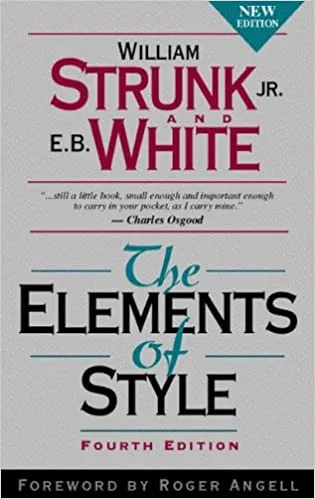
The Elements of Style
As a rule, single sentences should not be written or printed as paragraphs. An exception may be made of sentences of transition, indicating the relation between the parts of an exposition or argument. In dialogue, each speech, even
Page: 27, Location: 409-411
As a rule, single sentences should not be written or printed as paragraphs. An exception may be made of sentences of transition, indicating the relation between the parts of an exposition or argument.
Page: 27, Location: 409-410
In dialogue, each speech, even if only a single word, is a paragraph by itself; that is, a new paragraph begins with each change of speaker. The application of this rule, when dialogue and narrative are combined, is best learned from examples in well-printed works of fiction.
Page: 27, Location: 411-413
The need of making a particular word the subject of the sentence will often, as in these examples, determine which voice is to be used.
Page: 36, Location: 539-540
A common fault is to use as the subject of a passive construction a noun which expresses the entire action, leaving to the verb no function beyond that of completing the sentence.
Page: 37, Location: 567-568
should contain no unnecessary words, a paragraph no unnecessary sentences, for the same reason that a drawing should have no unnecessary lines and a machine no unnecessary parts. This requires not that the writer make all his sentences short, or that he avoid all detail and treat his subjects
Page: 42, Location: 632-633
Vigorous writing is concise. A sentence should contain no unnecessary words, a paragraph no unnecessary sentences, for the same reason that a drawing should have no unnecessary lines and a machine no unnecessary parts. This requires not that the writer make all his sentences short, or that he avoid all detail and treat his subjects only in outline, but that every word tell.
Page: 42, Location: 631-634
Correlative expressions (both, and; not, but; not only, but also; either, or; first, second, third; and the like) should be followed by the same grammatical construction. Many violations of this rule can be corrected by rearranging the sentence.
Page: 49, Location: 749-751
principal means of showing their relationship. The writer must therefore, so far as possible, bring together the words, and groups of words, that are related in thought, and keep apart those which are not so related.
Page: 51, Location: 774-775
The position of the words in a sentence is the principal means of showing their relationship. The writer must therefore, so far as possible, bring together the words, and groups of words, that are related in thought, and keep apart those which are not so related.
Page: 51, Location: 773-775
pronoun should come, as a rule, immediately
Page: 52, Location: 790-790
In summarizing the action of a drama, the writer should always use the present tense. In summarizing a poem, story, or novel, he should preferably use the present, though he may use the past if he prefers. If the summary is in the present tense, antecedent action should be expressed by the perfect; if in the past, by the past perfect.
Page: 55, Location: 837-839
In presenting the statements or the thought of some one else, as in summarizing an essay or reporting a speech, the writer should avoid intercalating such expressions as “he said,” “he stated,” “the speaker added,” “the speaker then went on to say,” “the author also thinks,” or the like. He should indicate clearly at the outset, once for all, that what follows is summary, and then waste no words in repeating the notification.
Page: 56, Location: 853-856
The proper place for the word, or group of words, which the writer desires to make most prominent is usually the end of the sentence.
Page: 57, Location: 866-867
The principle that the proper place for what is to be made most prominent is the end applies equally to the words of a sentence, to the sentences of a paragraph, and to the paragraphs of a composition.
Page: 60, Location: 905-907
To compare to is to point out or imply resemblances, between objects regarded as essentially of different order; to compare with is mainly to point out differences, between objects regarded as essentially of the same order.
Page: 68, Location: 1040-1042
Consider. Not followed by as when it means, “believe to be.” “I consider him thoroughly competent.” Compare, “The lecturer considered Cromwell first as soldier and second as administrator,” where “considered” means “examined” or “discussed.”
Page: 69, Location: 1047-1049
Fact. Use this word only of matters of a kind capable of direct verification, not of matters of judgment. That a particular event happened on a given date, that lead melts at a certain temperature, are facts. But such conclusions as that Napoleon was the greatest of modern generals, or that the climate of California is delightful, however incontestable they may be, are not properly facts.
Page: 70, Location: 1070-1073
